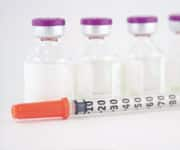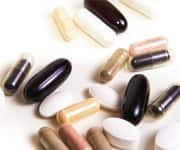Life Extension Magazine®
Metformin May Reduce Risk Of Glaucoma | |
|
Researchers at the University of Michigan Kellogg Eye Center, Ann Arbor, say the popular diabetes drug metformin may be associated with a reduction in open-angle glaucoma.* In a study of 150,016 diabetes patients 40 years and older with no pre-existing glaucoma, lead researcher Julia Richards, MD, and colleagues found that 3.9% (5,893) developed open-angle glaucoma. According to Richards, “the risk for open-angle glaucoma was 25% lower in patients with documented cumulative metformin use of more than 1,110 grams over two years (average dose, 2 grams/day) than in those with no metformin use.” The biggest risk reduction was linked with the highest baseline risk and the highest glycated hemoglobin (HbA1c) levels. “As we looked at higher-risk populations with higher HbA1c levels, we found a greater reduction in risk. The people who benefited the least were already at low risk and had well-controlled diabetes,” said Dr. Richards. She added that the study supports the concept that metformin is a geroprotective, or anti-aging, drug because it produces effects that mimic caloric restriction. Editor’s Note: “There are a variety of things we don’t know at this point,” said Dr. Richards. “We don’t know how our findings relate to uninsured populations, if they apply to nondiabetic individuals, if specific factors like intraocular pressure or age of onset play a role, or if the benefits extend to other types of glaucoma.” —A. Kessler |
|
| Reference | |
* Dr. Richards presented her findings at the Association for Research in Vision and Ophthalmology 2014 Annual Meeting in Orlando, Florida. |
|
Terminally Ill Patients Deserve “The Right To Try Act” Allowing Access To Experimental Treatment | |
Darcy Olsen and Richard Garr of the Goldwater Institute wrote an editorial in USA Today advocating a terminal patient’s right to try experimental medications that have passed Phase 1 of the FDA-approved safety trials, but are still under clinical development.* “Why are people dying when promising treatment exists?” the authors ask. Terminal patients don’t have the 10 years on average it takes to bring a new drug to market. Designed by the Goldwater Institute, the Right To Try initiative would allow terminal patients access to investigational drugs that have completed basic safety testing, thereby dramatically reducing wait times, and most importantly, potentially saving lives. To date, the bill has passed into law in Colorado, Louisiana, and Missouri. Voters in Arizona will consider it on this November’s ballot. Editor’s Note: Darcy Olsen is president of the Goldwater Institute, a nonprofit public advocacy group and research organization that developed the Right To Try Act. Richard Garr is chair of the Goldwater Institute’s Right To Try National Advisory Council and CEO of Neuralstem Inc., which develops neural stem cell therapies. —A. Kessler |
|
| Reference | |
* USA Today. 2014 May 28. |
|
Diabetes Rates Continue To Climb | |
On June 10, 2014, the Centers for Disease Control and Prevention announced that the number of Americans who have diabetes continues to climb, and there are now more than 29.1 million American adults living with the disease, an increase of 3.3 million cases since the last statistics were released in 2011.* And the CDC estimates that more than 25% of those adults don’t even know they are sick. Another 86 million—over a third of the adult American population—have blood sugar levels that are high enough to qualify them as prediabetic. Nearly 90% of these prediabetics don’t know that their levels are higher than normal and that 15 to 30% of them will develop diabetes within five years if they don’t make lifestyle changes now. “These new numbers are alarming and underscore the need for an increased focus on reducing the burden of diabetes in our country,” said Ann Albright, the CDC’s Director of the Division of Diabetes Translation. “It’s urgent we take swift action to effectively treat and prevent this serious disease.” Editor’s Note: According to the 2014 report, diabetes is affecting people at a younger age as well. More than 208,000 Americans younger than age 20 have already been diagnosed with either type I or type II diabetes. —A. Kessler |
|
| Reference | |
* National Diabetes Statistics Report, released by the Centers for Disease Control and Prevention. June 10, 2014. |
|
High Doses Of Vitamin C Reduce Epstein-Barr Viral Infection | |
Medical Science Monitor reported a benefit for intravenous vitamin C in patients with high levels of antibodies to the Epstein-Barr virus (EBV), which has been implicated in chronic fatigue syndrome, Burkitt’s lymphoma, Hodgkin’s disease, and some autoimmune conditions.* “This is, to our knowledge, the first clinical study of ascorbic acid and EBV infection,” announced authors Nina A. Mikirova and Ronald Hunninghake of the Riordan Clinic, in Wichita, Kansas. The duo evaluated data from 35 men and women diagnosed with chronic fatigue or other conditions who had Epstein-Barr virus antibodies measured before and after treatment with 7.5 to 50 grams of intravenous vitamin C. Thirty-two of the 35 subjects showed improvement following vitamin C treatment. Subjects who had five or more vitamin C infusions had a significantly greater percent decrease in EBV antibodies over time in comparison with infected individuals evaluated by the clinic who did not receive intravenous vitamin C. Editor’s Note: The researchers recommend further research involving a combination of vitamins C and D and other nutrients in EBV-infected patients. —D. Dye | |
| Reference | |
* Med Sci Mon. 2014 May 4. | |
Fasting Regenerates The Immune System | |
The June 5, 2014, issue of the journal Cell Stem Cell published the findings of Valter D. Longo and colleagues at the University of Southern California, which found a rejuvenating effect for fasting on immune system cells.* “What we started noticing in both our human work and animal work is that the white blood cell count goes down with prolonged fasting,” Dr. Longo observed. “Then when you re-feed, the blood cells come back.” Dr. Longo and his associates determined that the reduction in these immune system cells triggers the stem cell-based regeneration of new cells. Fasting was found to reduce an enzyme known as PKA, which, when lowered, extended the life span of simple organisms in previous research conducted by the team. “PKA is the key gene that needs to shut down in order for these stem cells to switch into regenerative mode,” Dr. Longo explained. Editor’s Note: “The good news is that the body got rid of the parts of the system that might be damaged or old, the inefficient parts, during the fasting,” Dr. Longo noted. “Now, if you start with a system heavily damaged by chemotherapy or aging, fasting cycles can generate, literally, a new immune system.” —D. Dye | |
| Reference | |
* Cell Stem Cell. 2014 Jun 5;14(6):810-23. | |
Watch Out For “Gerontogens” | |
A review published online in Trends in Molecular Medicine discusses the dangers associated with gerontogens: environmental factors that promote physiologic (as opposed to chronologic) aging.* Potential gerontogens include benzene, arsenic, ultraviolet light, ionizing radiation, chemotherapy, psychological stress, and cigarette smoke. Although exposure to some of these factors may be unavoidable, the concept of gerontogen-generated aging leaves room for optimism because it views physiologic aging as predominantly preventable. (Gerontologist Tom Perls has estimated that the rate of aging is 50 to 75% determined by nongenetic factors.) The research team from the University of North Carolina plans to further study the effects of gerontogens via a novel mouse model. Author Norman E. Sharpless and colleagues predict the development of blood tests to evaluate a number of molecular age biomarkers in order to understand individual differences in the rate of aging and to assess the age-promoting effect of gerontogens. Editor’s Note: “We believe just as an understanding of carcinogens has informed cancer biology, so will an understanding of gerontogens benefit the study of aging,” Dr. Sharpless stated. “By identifying and avoiding gerontogens, we will be able to influence aging and life expectancy at a public health level.” —D. Dye | |
| Reference | |
* Trends Mol Med. 2014 May 28. | |
Review Affirms Higher Vitamin D Levels Are Associated With A Reduced Risk Of Premature Mortality | |
The results of a systematic view published on June 12, 2014, in the American Journal of Public Health reaffirms what a number of studies conducted over the past decade have indicated: Having a higher serum level of vitamin D is associated with a lower risk of dying prematurely.* Cedric Garland, DrPH, and colleagues selected 32 studies that provided data on a total of 566,583 men and women for their analysis. They determined that having a vitamin D level of 30 ng/mL is associated with approximately half the risk of dying over an average nine years of follow-up in comparison with lower levels. Dr. Garland, who is a professor at UC San Diego, noted that serum levels of vitamin D lower than 30 ng/mL are estimated to exist in two-thirds of the US population. Editor’s Note: Dr. Garland observed that, “Three years ago, the Institute of Medicine (IOM) concluded that having a too-low blood level of vitamin D was hazardous. This study supports that conclusion, but goes one step further. The 20 ng/mL blood level cutoff assumed from the IOM report was based solely on the association of low vitamin D with risk of bone disease. This new finding is based on the association of low vitamin D with risk of premature death from all causes, not just bone diseases.” Life Extension continues to recommend that people maintain 25-hydroxyvitamin D blood levels between 50-80 ng/mL. —D. Dye | |
| Reference | |
* Am J Public Health. 2014 Jun 12. | |
Experts Take Issue With Anti-Supplement Sentiment | |
|
A letter composed by such notable authorities as Bruce N. Ames, PhD, and Jeffrey Blumberg, PhD, appeared in the Annals of Internal Medicine in response to an editorial titled “Enough is Enough: Stop Wasting Money on Vitamin and Mineral Supplements.”* The authors of the letter assert that, rather than the case being closed as stated in the article, nutritional supplements do offer significant benefits. “There are many issues that have helped to mislead people when it comes to the study of micronutrients,” stated first author Balz Frei, director of the Linus Pauling Institute. “For instance, most research is done without first checking to see if a person is inadequate in a nutrient and you won’t find much effect from a supplement if it isn’t needed. “In similar fashion, too much research has been done with groups such as doctors and nurses who are probably not representative of the general population,” he added. Editor’s Note: Dr. Frei added, “It’s naive to ignore the fact that most people have micronutrient inadequacies, and wrong to condemn a daily supplement that could cover these nutritional gaps safely and at low cost. There’s strong evidence that a multivitamin/mineral supplement supports normal functioning of the body and helps improve overall health, and may even help lower chronic disease risk. It’s irresponsible to ignore decades of nutrition research and tell the people of the United States they have no need for a supplement that could be so helpful, and costs as little as $1 a month.” —D. Dye | |
| Reference | |
* Ann Int Med. 2014 Jun 3. | |
Omega-3 Fatty Acids Cut Tobacco Craving | |
A report published June 4, 2014, in the Journal of Psychopharmacology reveals the outcome of a trial of orally administered EPA and DHA, which uncovered a reduction in smoking and tobacco craving among those who received the supplements.* Forty-eight regular smokers were given 2,710 mg EPA and 2,040 mg DHA or a placebo for one month. Tobacco craving and number of cigarettes smoked each day were assessed at the beginning of the trial, at the end of the treatment period, and 30 days following the end of treatment. Participants who received omega-3 fatty acids had significantly less craving for tobacco at the end of one month in comparison with initially assessed levels. Although craving rose in the month following the treatment period, it was still lower than that experienced initially among those who received EPA and DHA. In contrast, participants who received the placebo reported similar craving levels at all time points evaluated. Editor’s Note: Additionally, those who received omega-3 smoked 11.2% fewer cigarettes after one month in comparison to the amount smoked at the beginning of the study. —D. Dye | |
| Reference | |
*J Psychopharmacol. 2014 June 4. |
|
Soy Compound Helps Prevent Prostate Cancer Metastasis | |
In an article published May 28, 2014, in the American Journal of Clinical Nutrition, researchers at Northwestern University report the outcome of experiments conducted by their group and others that shows a protective effect for the soy isoflavone genistein against prostate cancer cell detachment, invasion, and metastasis.* Research conducted by the team, described in 1996 in Clinical & Experimental Metastasis and in Molecular Pharmacology in 1997, demonstrated that genistein dose-dependently inhibited human prostate cancer cell detachment, which is due to the isoflavone’s ability to increase cell adhesion. In further research, the group implanted human prostate cancer cells in mice and observed that cellular adhesion increased with the administration of genistein. This was accomplished at plasma genistein levels similar to those measured in men given 150 mg/day of genistein, indicating that the compound inhibits cell detachment at concentrations attainable by humans. Editor’s Note: In addition to detaching from the extracellular matrix, invasion is facilitated by the production of matrix metalloproteinases (MMPs) that degrade surrounding tissue. A relatively low concentration of genistein, corresponding to concentrations of free genistein attained in the blood after dietary consumption, was found to reduce the expression and activity of MMP-2 in cultured human prostate cancer cells. Genistein was also shown to directly inhibit prostate cancer cell invasion at this concentration in other research conducted by the team. —D. Dye | |
| Reference | |
|
*Am J Clin Nutr. 2014 May 28. | |
Vitamin D Insufficiency Associated With HIV Progression | |
|
The Journal of Infectious Diseases reported findings from the PEARLS (Perineal Assessment and Repair Longitudinal Study) trial of HIV-positive men and women undergoing antiretroviral treatment, which reveal a protective effect for higher vitamin D levels against disease progression and premature death.* The current study compared participants who developed a World Health Organization classified stage III or IV event (defined by advanced or severe symptoms) or death to those who did not develop this outcome. Low serum 25-hydroxyvitamin D levels, defined as less than 32 ng/mL, were found in an average of 49% of the participants. Subjects with low vitamin D had more than double the adjusted risk of experiencing a stage III or IV disease event or death by 96 weeks than those with sufficient vitamin D levels. Of the subjects who experienced this outcome, 59% had low vitamin D levels, and the median time to the development of the outcome was shorter in the vitamin-insufficient group. Editor’s Note: In a separate analysis of virologic failure, defined as two successive plasma HIV-1 RNA measurements higher than 1,000 copies per mL at or after the study’s 16 week visit, those with low vitamin D levels had twice the risk compared to those with sufficient levels. —D. Dye | |
| Reference | |
*J Infect Dis. 2014 May 5. |









